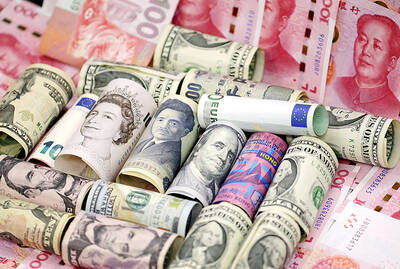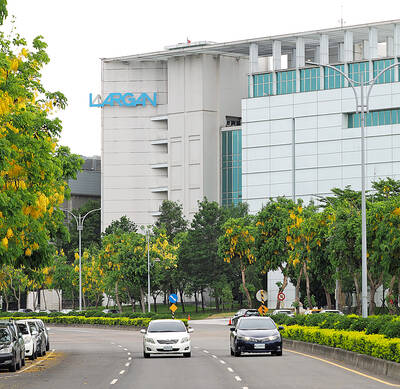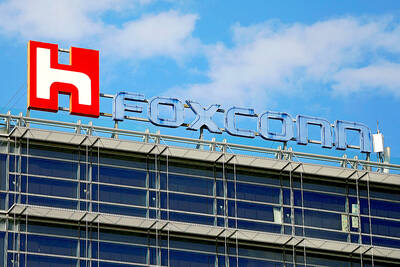Export orders last month grew for the eighth straight month at an annual rate of 4.9 percent, benefiting from rising demand for advanced chips used in artificial intelligence (AI) and high-performance computing (HPC) applications, the Ministry of Economic Affairs said yesterday.
Export orders expanded to US$55.45 billion last month, compared with US$52.87 billion a year earlier and marking the strongest level since September 2022, ministry data showed.
In the first 10 months, accumulated export orders totaled US$484.35 billion, up 3.8 percent annually, the data showed.

Photo: CNA
Orders for electronic products, including semiconductors, registered the fastest annual growth of 11.2 percent last month to US$20.91 billion, marking the best October performance. Orders for the US market surged 12.6 percent annually to US$19.15 billion, making it the fastest growing market in the month, the ministry said.
“Last month’s performance matched our expectations, mostly driven by the electronics segment, or mostly advanced chips. For the full year, we expect export orders to return to the annual growth path,” Department of Statistics Director Huang Yu-ling (黃于玲) said.
“What is more, the traditional industries are recovering, too, as reflected in last month’s figures. Their growth may look mild, but the uptrend is confirmed,” she added.
Export orders this month are expected to grow between 4.7 percent and 8.6 percent year-on-year to between US$53 billion and US$55 billion, the ministry said.
That would represent a sequential reduction of between 0.8 percent and 4.4 percent, in line with seasonal patterns, the ministry said.
“Advanced chips and AI servers are the growth drivers,” Huang said.
Information and communications technology products last month saw orders rise 0.5 percent annually to US$17.58 billion as strong demand for AI and cloud-based applications fueled demand for servers and networking equipment, the ministry said.
Orders for optronic products shrank 0.7 percent to US$1.66 billion last month, due to falling prices of TV display panels, but those for base metals advanced 7.4 percent to US$2.13 billion, thanks to rising demand for steel products, it said.
Orders for machinery products and mechanical equipment rose 5 percent to US$1.54 billion last month, primarily driven by robust demand for semiconductor manufacturing equipment and automation systems, the ministry said, adding that orders for machine tools dipped.
Orders for plastic and rubber products edged higher by 1.8 percent to US$1.54 billion last month attributable to the growth of rubber material and gloves, while plastic raw material demand sank due to competition from global rivals, the ministry said.
Chemical orders climbed 3.9 percent to US$1.39 billion last month, benefiting from rising demand for medicine and electronic chemicals, but petrochemical orders dropped on lower prices, it said.

Taiwan’s foreign exchange reserves hit a record high at the end of last month, surpassing the US$600 billion mark for the first time, the central bank said yesterday. Last month, the country’s foreign exchange reserves rose US$5.51 billion from a month earlier to reach US$602.94 billion due to an increase in returns from the central bank’s portfolio management, the movement of other foreign currencies in the portfolio against the US dollar and the bank’s efforts to smooth the volatility of the New Taiwan dollar. Department of Foreign Exchange Director-General Eugene Tsai (蔡炯民)said a rate cut cycle launched by the US Federal Reserve

Handset camera lens maker Largan Precision Co (大立光) on Sunday reported a 6.71 percent year-on-year decline in revenue for the third quarter, despite revenue last month hitting the highest level in 11 months. Third-quarter revenue was NT$17.68 billion (US$581.2 million), compared with NT$18.95 billion a year earlier, the company said in a statement. The figure was in line with Yuanta Securities Investment Consulting Co’s (元大投顧) forecast of NT$17.9 billion, but missed the market consensus estimate of NT$18.97 billion. The third-quarter revenue was a 51.44 percent increase from NT$11.67 billion in the second quarter, as the quarter is usually the peak

Nvidia Corp’s major server production partner Hon Hai Precision Industry Co (鴻海精密) reported 10.99 percent year-on-year growth in quarterly sales, signaling healthy demand for artificial intelligence (AI) infrastructure. Revenue totaled NT$2.06 trillion (US$67.72 billion) in the last quarter, in line with analysts’ projections, a company statement said. On a quarterly basis, revenue was up 14.47 percent. Hon Hai’s businesses cover four primary product segments: cloud and networking, smart consumer electronics, computing, and components and other products. Last quarter, “cloud and networking products delivered strong growth, components and other products demonstrated significant growth, while smart consumer electronics and computing products slightly declined,” compared with the

The US government on Wednesday sanctioned more than two dozen companies in China, Turkey and the United Arab Emirates, including offshoots of a US chip firm, accusing the businesses of providing illicit support to Iran’s military or proxies. The US Department of Commerce included two subsidiaries of US-based chip distributor Arrow Electronics Inc (艾睿電子) on its so-called entity list published on the federal register for facilitating purchases by Iran’s proxies of US tech. Arrow spokesman John Hourigan said that the subsidiaries have been operating in full compliance with US export control regulations and his company is discussing with the US Bureau of